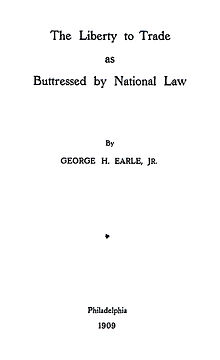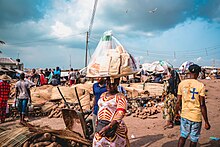
Back Handel (ekonomie) Afrikaans Handel ALS ንግድ Amharic Comercio AN تجارة Arabic ܬܐܓܘܪܬܐ ARC Comerciu AST Kommersiya Azerbaijani تیجارت AZB Сауҙа Bashkir



| Business administration |
|---|
| Management of a business |
Trade involves the transfer of goods and services from one person or entity to another, often in exchange for money. Economists refer to a system or network that allows trade as a market.
Traders generally negotiate through a medium of credit or exchange, such as money. Though some economists characterize barter (i.e. trading things without the use of money[1]) as an early form of trade, money was invented before written history began. Consequently, any story of how money first developed is mostly based on conjecture and logical inference. Letters of credit, paper money, and non-physical money have greatly simplified and promoted trade as buying can be separated from selling, or earning. Trade between two traders is called bilateral trade, while trade involving more than two traders is called multilateral trade.
In one modern view, trade exists due to specialization and the division of labor, a predominant form of economic activity in which individuals and groups concentrate on a small aspect of production, but use their output in trade for other products and needs.[2] Trade exists between regions because different regions may have a comparative advantage (perceived or real) in the production of some trade-able goods – including the production of scarce or limited natural resources elsewhere. For example, different regions' sizes may encourage mass production. In such circumstances, trading at market price between locations can benefit both locations. Different types of traders may specialize in trading different kinds of goods; for example, the spice trade and grain trade have both historically been important in the development of a global, international economy.

Retail trade consists of the sale of goods or merchandise from a very fixed location[3] (such as a department store, boutique, or kiosk), online or by mail, in small or individual lots for direct consumption or use by the purchaser.[4] Wholesale trade is the traffic in goods that are sold as merchandise to retailers, industrial, commercial, institutional, or other professional business users, or to other wholesalers and related subordinated services.
Historically, openness to free trade substantially increased in some areas from 1815 until the outbreak of World War I in 1914. Trade openness increased again during the 1920s but collapsed (in particular in Europe and North America) during the Great Depression of the 1930s. Trade openness increased substantially again from the 1950s onward (albeit with a slowdown during the oil crisis of the 1970s). Economists and economic historians contend that current levels of trade openness are the highest they have ever been.[5][6][7]
- ^ Samuelson, P. (1939). "The Gains from International Trade". The Canadian Journal of Economics and Political Science. 5 (2): 195–205. doi:10.2307/137133. JSTOR 137133.
- ^ Dollar, D.; Kraay, A. (2004). "Trade, Growth, and Poverty" (PDF). The Economic Journal. 114 (493): F22 – F49. CiteSeerX 10.1.1.509.1584. doi:10.1111/j.0013-0133.2004.00186.x. S2CID 62781399. Archived from the original (PDF) on 7 March 2004. Retrieved 26 October 2017.
- ^ Compare peddling and other types of retail trade:Hoffman, K. Douglas, ed. (2005). Marketing principles and best practices (3 ed.). Thomson/South-Western. p. 407. ISBN 978-0-324-22519-8. Archived from the original on 22 October 2022. Retrieved 3 May 2018.
Five types of nonstore retailing will be discussed: street peddling, direct selling, mail-order, automatic-merchandising machine operators, and electronic shopping.
- ^ "Distribution Services". Foreign Agricultural Service. 9 February 2000. Archived from the original on 15 May 2006. Retrieved 4 April 2006.
- ^ Federico, Giovanni; Tena-Junguito, Antonio (2019). "World Trade, 1800-1938: A New Synthesis". Revista de Historia Economica – Journal of Iberian and Latin American Economic History. 37 (1): 9–41. doi:10.1017/S0212610918000216. hdl:10016/36110. ISSN 0212-6109.
- ^ Federico, Giovanni; Tena-Junguito, Antonio (28 July 2018). "The World Trade Historical Database". VoxEU.org. Archived from the original on 7 October 2019. Retrieved 7 October 2019.
- ^ Bown, C. P.; Crowley, M. A. (1 January 2016), Bagwell, Kyle; Staiger, Robert W. (eds.), The Empirical Landscape of Trade Policy (PDF), Handbook of Commercial Policy, vol. 1, North-Holland, pp. 3–108, doi:10.1016/bs.hescop.2016.04.015, ISBN 978-0444632807, S2CID 204484666, archived (PDF) from the original on 25 February 2021, retrieved 7 October 2019